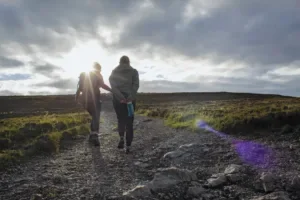AUSTIN, Texas—Michael Collins calls himself an archeologist but the lay person might call him a prehistoric detective. He devotes himself to solving mysteries of the past, a vocation that sometimes means he attempts to make by hand tools like those native Americans made more than 10,000 years ago.
Of particular interest to Dr. Collins, who is associate director of The University of Texas Archeological Research Laboratory (TARL), are flint spearheads made by what is called the Folsom culture of people.
These very thin, distinctly shaped spear points were used to kill giant bison long ago extinct. Since the discovery of the points embedded in the fossilized rib cage of a giant bison in eastern New Mexico, scientists have worked to replicate the ancient technology.
It’s a mystery that captivates Collins and more than 25 other scholars and anthropologists, who will be meeting at TARL March 3-6 to pool their research findings on this extraordinary technology.
These same scientists met two years ago at a similar TARL symposium to unlock the mystery, but were unable to fully do so. They made dozens of the spear points, but the process needed to be refined. Each has spent the past two years doing further research. They will spend much of the Folsom Workshop, as it is called, doing “flint knapping,” or attempting to make Folsom points.
What makes the spear heads so difficult to create is the fragility of the flint and the distinctive groove or flute that appears on each side of Folsom points. Scientists believe the grooves were made so the point could be set firmly in the spear handle. Folsom points, which have been unearthed in Texas, New Mexico and Oklahoma and through much of the Great Plains and Southwest, are about two inches long, three-quarters inch wide and are less than an eighth-inch thick.
Collins said he believes the tiny spear points proved deadly with such giant prey in part because the animals may have been forced off a cliff and injured or may have been driven into arroyos or other traps.
Scientific reporting of the discovery of these distinctive spearheads with the bones of an Ice Age bison near Folsom, N.M., in 1926 caused an explosion in the anthropological world. An African-American cowboy named George McJunkin, who was foreman on a ranch near Folsom, first discovered the flint points while riding a fence line after a major flood in 1908. The heads were inside the rib cage of a giant bison.
McJunkin attempted to get the scientific community interested in his discovery, but he was unsuccessful. In the early part of the 20th century, scientists and historians believed that humans did not inhabit the Americas until at least 5,000 years after the Ice Age and the extinction of large mammals like the giant bison.
McJunkin’s discovery, if true, meant that humans had lived in North and South America for at least 10,000 years and had lived alongside the immense creatures.
In 1926, after McJunkin died, paleontologists from Denver visited the Folsom site and were astonished at their findings. They sent telegrams to other paleontologists and archeologists inviting them to visit the site. The study of Folsom technology has been under way since then.
Collins said the prehistoric people probably used other stones, antlers and possibly bones to shape the points. Scientists have been able to replicate the delicate points but many details of the process remain controversial.
The objective is to replicate Folsom points using equipment made only of materials available to hunters 10,000 years ago. Scholars also are seeking to use equipment that is as simple and lightweight as possible and would have accommodated the mobile lifestyle of the Folsom people. Collins said clarifying these issues would tell scientists more about how these prehistoric people lived.
Another discovery near Clovis, N.M., in 1935 sent even further shock waves through the scientific community. More ancient spear points were found, this time with bones of an extinct mammoth dating back 11,000 years. After that revelation, the Clovis people were believed to be the oldest in the Americas.
Despite the Clovis discovery, Collins said he believed humans inhabited the Americas even earlier. In 1985, Collins participated in an excavation that proved his hunch. The dig was on the Monte Verde site in Southern Chile, where radio carbon dating indicates the presence of people 12,500 years ago. The finding has become widely accepted only in the past two years.
That means if the Americas were populated by peoples crossing the Bering Strait from Asia, then they must have arrived hundreds or thousands of years earlier, according to Collins’ calculations.
Collins said he has reviewed the evidence from three excavated sites in Texas and believes that the elusive Folsom technology may have originated in the Lone Star State. Remnants of the tools have been unearthed at sites near Cedar Park, in San Antonio and in Bell County.
For more information about the conference contact Dr. Collins at 471-5992.



